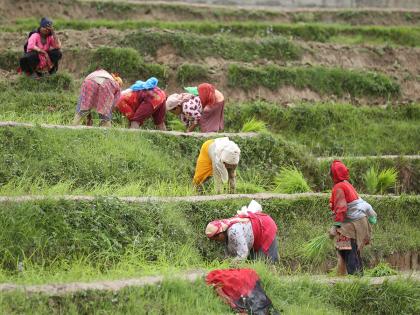Splashing mud and singing, Nepal marks "Paddy Day" celebrating rice and rituals
By ANI | Updated: June 29, 2025 20:28 IST2025-06-29T20:22:23+5:302025-06-29T20:28:55+5:30
Lalitpur [Nepal], June 29 : Soaking in mud and water, farmers continuously worked on the field, levelling the mud ...

Splashing mud and singing, Nepal marks "Paddy Day" celebrating rice and rituals
Lalitpur [Nepal], June 29 : Soaking in mud and water, farmers continuously worked on the field, levelling the mud to ensure an even level and continuous flow of water, creating a favourable typography for the paddy saplings to grow.
The farmers of Nepal, along with their farming activities on Sunday, also marked "Paddy Day" while celebrating rice and its associated rituals.
Plantation of paddy saplings in the field known as "Ropain" brings high significance for farmers in Nepal, which is primarily dominant during the monsoon season, which starts from June and lasts for four months.
"Ashar 15 is given more importance because in the bygone days many of the places didn't use to have enough water (for plantation of saplings) at the beginning of the month of Ashar (third month as per Nepali calendar) and till the mid of Ashar the rain would bring enough water to sow, that's why it is being given utmost importance," Sudama Karki, a farmer in outskirts of Lalitpur told ANI.
While planting the saplings, farmers run behind each other, smearing mud on their faces, splashing muddy water as a means of fun. These sorts of activities are seen at high altitudes in the Himalayan Nation on 15 of Ashar, which is marked as National Paddy Day since 2005. This day was previously observed as the start of the cultivation season with the onset of the monsoon.
As farmers gather, a feast is thrown, which includes beaten rice, curd, pickle, and homemade brew. Because of this long-run tradition of having victuals, the Ashar-15 is also known as "Dahi (Curd)- Chiura (Beaten-rice)" eating day.
Almost 80 per cent of Nepal's annual rainfall is received during the monsoon season (June-September). The average annual rainfall is 1,600 mm, but it varies by eco-climatic zones (3,345 mm in Pokhara and below 300 mm in Mustang).
In Nepal, the paddy is cultivated from an altitude of 60 m above sea level in Terai to 3000 meters in the hills of Jumla's Chhumchaur. Nepal annually produces about 5.5 million metric tons of paddy while the consumption stands at 7 million metric tons. Last year Nepal produced a total of 5.55 million metric tons from 1.45 million hectares of land.
Disclaimer: This post has been auto-published from an agency feed without any modifications to the text and has not been reviewed by an editor
Open in app

